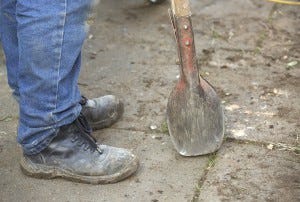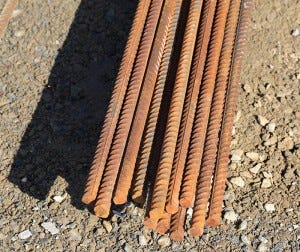
The most important part of setting up your electric horse fence is installing a proper ground system. Through the years, we’ve found that nearly 90% of all problems in an electric fence are the result of poorly or improperly installed grounds.
With that in mind, here is a quick guide to grounding your electric fencing for horses.
If It Isn't Grounded, It Won't Shock
So, how does a grounded fence work? When an animal touches the electrically charged fence wire, the animal feels the electric current as the charge passes through the body. The charge then completes the circuit through the soil via the ground rod and then up the ground wire to the ground terminal charger.
If the animal and the ground terminal charger are not sufficiently grounded, the path of electric current cannot be completed and your animal will not feel the shock. Since the soil provides half of the electric field circuit, it is crucial to have a properly installed ground circuit.
When you wire your electric horse fence, always electrify the top strand. The strand that’s below that should be a ground wire. Beyond that, add and electrify strands according your containment needs – three for mares and geldings and up to five for stallions.
Installing Ground Rods
 When grounding your fence, use a minimum of three ground rods spaced at least 10 feet apart. Dig a hole with a fence-post digger and then thoroughly and continually moisten the soil inside the hole to assist in driving the rod the rest of the way. For best results, drive the rods until they are flush with the soil.
When grounding your fence, use a minimum of three ground rods spaced at least 10 feet apart. Dig a hole with a fence-post digger and then thoroughly and continually moisten the soil inside the hole to assist in driving the rod the rest of the way. For best results, drive the rods until they are flush with the soil.
With dry or sandy soil, you may need more ground rods than the recommended three. This is because there’s less moisture in these soils, which makes it more difficult for energy to move to your fence. With more rods, you have more opportunities to collect energy.
8 Grounding Tips for Electric Fencing
There’s plenty you can do to ensure you get the best from your electric fence. Try these ideas to make your fence reach its full potential:

- Right Metals. The best ground rods are made from copper or galvanized metal and should be at least 4 feet long. The longer the better!
- Wrong Metals. A simple pipe or a piece of rebar make poor grounding rods. These are usually made of metals that will corrode after just a few years in the ground and cause your system to fail.
- Match Metals. Don’t mix metals when you are installing or clamping your ground rods. When you use different metals, you trigger a reaction called electrolysis, which will corrode these connections.
- Test. Check your voltage periodically to ensure you have adequate grounding. Checking during the driest part of the year and the wettest is highly recommended.
- Wire. To connect your ground rods to the fence charger, use a 10- to 14-guage insulated lead-out wire rated at 20,000 volts or better. Smaller wires, including those you use in your home, cannot carry that level of voltage.
- More Rods. If you aren’t satisfied with the shock your fence is delivering, add more ground rods. This spreads out the charge collection area, which delivers a more powerful shock.
- Moisture Absorber. Another option to create a better ground in dry soil is by drilling a larger than-normal hole and filling it with a bentonite after inserting your grounding rod. This gel-like substance will wick moisture, creating a stronger current.
- Utilities. Don’t place your ground rods close to your utility poles or lines. If they are too close, you could see a disruption in your electrical or phone service.



